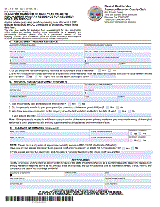
Claim for Transfer of Base Year Value to Replacement Primary Residence for Severely Disabled Persons
- Form Number: BOE-19-D
- Submission Deadline: N/A
- Topics: Assessor, Exclusions
- Last Updated: May 2021
General Information
Beginning April 1, 2021, California law allows an owner of a primary residence who is severely disabled to transfer the factored base year value of their primary residence to a replacement primary residence that is located anywhere in California and purchased or newly constructed within two years of the sale of the original primary residence.
If the replacement primary residence is of equal or lesser value than the original primary residence, the factored base year value of the original primary residence becomes the base year value of the replacement primary residence.
If the replacement primary residence is of greater value than the original primary residence, partial relief is available. The difference between the full cash value of the original primary residence and the full cash value of the replacement primary residence will be added to the factored base year value that is transferred to the replacement primary residence.
Under Revenue and Taxation Code section 110(b), “full cash value” is presumed to be the purchase price, unless it is established by evidence that the real property would not have transferred for that purchase price in an open market transaction.
A homeowner who is at least age 55 or severely disabled may transfer their base year value up to three times.
The disclosure of the social security number by the claimant of a replacement primary residence is mandatory. The number is used by the Assessor to verify the eligibility of the person claiming this exclusion and by the State of California to prevent more than three base year value transfers. This claim is confidential and not subject to public inspection.
A claim must be filed with the Assessor of the county in which the replacement property is located.
If your claim is approved, the base year value will be transferred to the replacement primary residence as of the latest qualifying event— the sale of the original primary residence, the purchase of the replacement primary residence, or the completion of construction of the replacement primary residence. This means that if you purchase or construct your replacement primary residence first and sell your original primary residence second, you will be responsible for the increased taxes on your replacement primary residence until your original primary residence is sold.
If you are filing a claim for additional treatment as the result of new construction performed on a replacement primary residence which has already been granted the benefit, you must complete the reverse side of this form and include a description of the new construction in Section B.3, if applicable. You may be eligible if the new construction is completed within two years of the date of sale of the original primary residence; you have notified the Assessor in writing of the completion of new construction within 6 months after completion; and the fair market value of the new construction (as confirmed by the Assessor) on the date of completion, plus the full cash value of the replacement primary residence at the time of its purchase/date of completion of new construction (as confirmed by the Assessor) does not exceed the market value of the original property as of its date of sale.